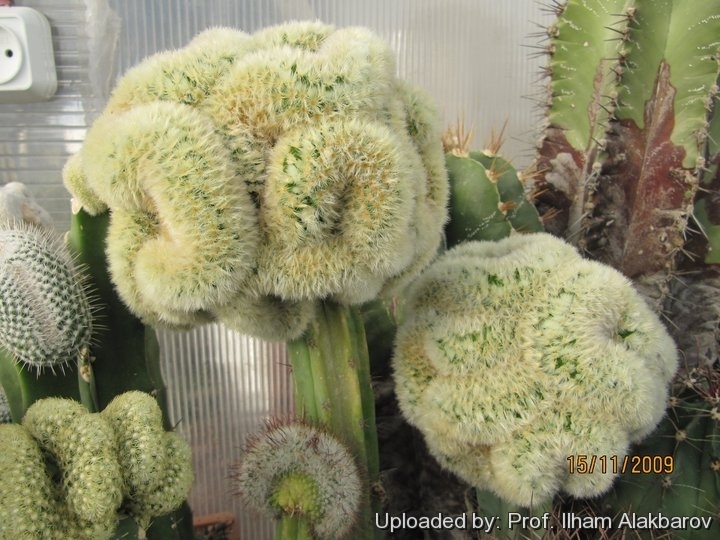Accepted Scientific Name: Mammillaria carmenae Castañeda
Anales Inst. Biol. Univ. Nac. Mexico 24(2): 233 (-235; fig. 12). 1954

Mammillaria carmenae f. cristata Photo by: Prof. Ilham Alakbarov
Origin and Habitat: Garden origin (Nursery produced cultivar). The natural species is endemic to a small area Between Ciudad Victoria and Iaumave, Tamaulipas, Mexico, Northern America.
Synonyms:
See all synonyms of Mammillaria carmenae
back
Accepted name in llifle Database:Mammillaria carmenae CastañedaAnales Inst. Biol. Univ. Nac. Mexico 24(2): 233 (-235; fig. 12). 1954Synonymy: 5
back
Description: Mammillaria carmenaeSN|29904]]SN|20921]] is a small solitary or clustering cactus with globose stems, the areoles with about 100 cream radial spines; white or pink-tinged flowers 1cm in length are borne towards the apex of each stem in spring and summer.
Crested form: The beautiful and very rare crested form (Mammillaria carmenae f. cristataSN|20921]]SN|29904]]) is sought after by specialized collectors and impassioned for its unique tufted appearance. It forms fan-shaped stems densely covered by fine yellow spines.
Stems: Fan shaped 3-5 cm in width, green.Without latex.
Tubercles: Conical.
Axil: Woolly and bristly.
Radial spines: More than 100, soft, fine, flexible, star-like, white or pale yellow (or gold), up to 5 mm long.
Central spines: There are no central spines.
Flowers: Diurnal, (usually) creamy white to pink or pale pink with pink tinged midribs, up to 11 mm long.
Blooming season (Europe): Plants blooms at the same time in late winter-early spring, and are very generous with their flowers.
Fruits: Greenish.
Seeds: Black.
Subspecies, varieties, forms and cultivars of plants belonging to the Mammillaria carmenae group
Bibliography: Major references and further lectures
1) Nathaniel Lord Britton, Joseph Nelson Rose “Cactaceae: Descriptions and Illustrations of Plants of the Cactus Family” Courier Dover Publications, 1963
2) James Cullen, Sabina G. Knees, H. Suzanne Cubey “The European Garden Flora Flowering Plants: A Manual for the Identification of Plants Cultivated in Europe, Both Out-of-Doors and Under Glass” Cambridge University Press, 11/Aug./2011
3) David Hunt, Nigel Taylor “The New Cactus Lexicon” DH Books, 2006 ISBN 0953813444, 9780953813445.
4) Edward F. Anderson “The Cactus Family” Timber Press, 2001
5) Clive Innes, Charles Glass “Cacti” Portland House, 01/May/1991
6) Fitz Maurice, B, Fitz Maurice, W.A., Hernández, H.M., Sotomayor, M. & Smith, M. 2013. "Mammillaria carmenae." The IUCN Red List of Threatened Species. Version 2014.3. <www.iucnredlist.org>. Downloaded on 21 December 2014.
Cultivation and Propagation: It is not too difficult in a greenhouse, although grows quite slowly. It is usually seen as a grafted plant but can grow on its own roots too.
Soil: Use a mineral well permeable soil with little organic matter (peat, humus).
Exposure: They need a good amount of light shade to full sun this help to keep the plants healthy, although slow growth.
Watering: Water sparingly from March till October (weekly during summertime, if the weather is sunny enough), with a little fertilizer added. Less or no water during cold winter months, or when night temperatures remain below 10° to prevent root loss. It is sensitive to overwatering (rot prone).
Fertilization: Feeding may not be necessary at all if the compost is fresh then, feed in summer only if the plant hasn't been repotted recently. Do not feed the plants from September onwards as this can cause lush growth which can be fatal during the darker cold months.
Hardiness: Keep perfectly dry in winter at temperatures from 5 to 15 degrees centigrade. In the rest period no high atmospheric humidity!! (Temperature Zone: USDA 9-11)
Crested growth: Unlike 'monstrose' varieties of plants, where the variation from normal growth is due to genetic mutation, crested growth can occur on normal plants. Sometimes it's due to variances in light intensity, or damage, but generally the causes are unknown. A crested plant may have some areas growing normally, and a cresting plant that looks like a brain, may revert to normal growth for no apparent reason. If you have any of the crested part left you need to remove the normal growth and leave the crested part behind this will need to be done regularly.
Propagation: Grafting or cuttings. Plants are usually grafted onto column-shaped cacti but proved to be able to produce their own roots if degrafted. Cuttings will take root in a minimum temperature of 20° C (but better in hot weather). Cuttings of healthy shoots can be taken in the spring and summer. Cut the stem with a sharp, sterile knife, leave the cutting in a warm, dry place for a week or weeks (depending on how thick the cutting is) until a callus forms over the wound. Once the callus forms, the cutting may be inserted in a container filled with firmed cactus potting mix topped with a surface layer of coarse grit. They should be placed in the coarse grit only; this prevents the cut end from becoming too wet and allows the roots to penetrate the rich compost underneath. The cuttings should root in 2 to 6 weeks. Large crested piece must be placed on the soil surface without burying the plant base down in the soil.










